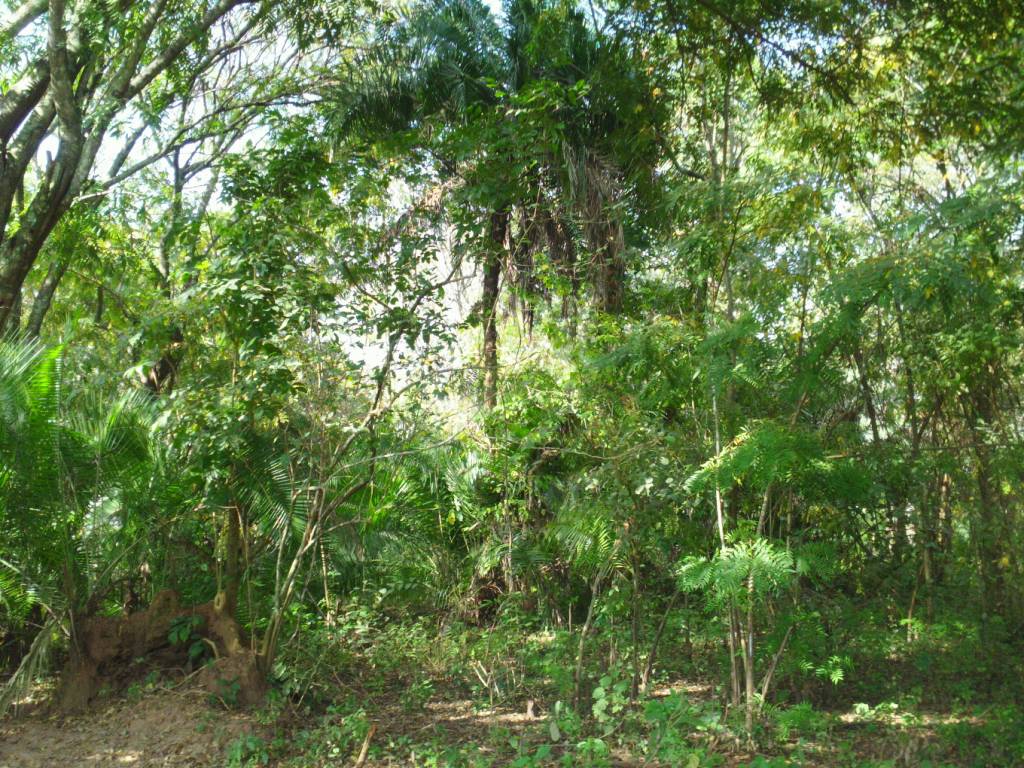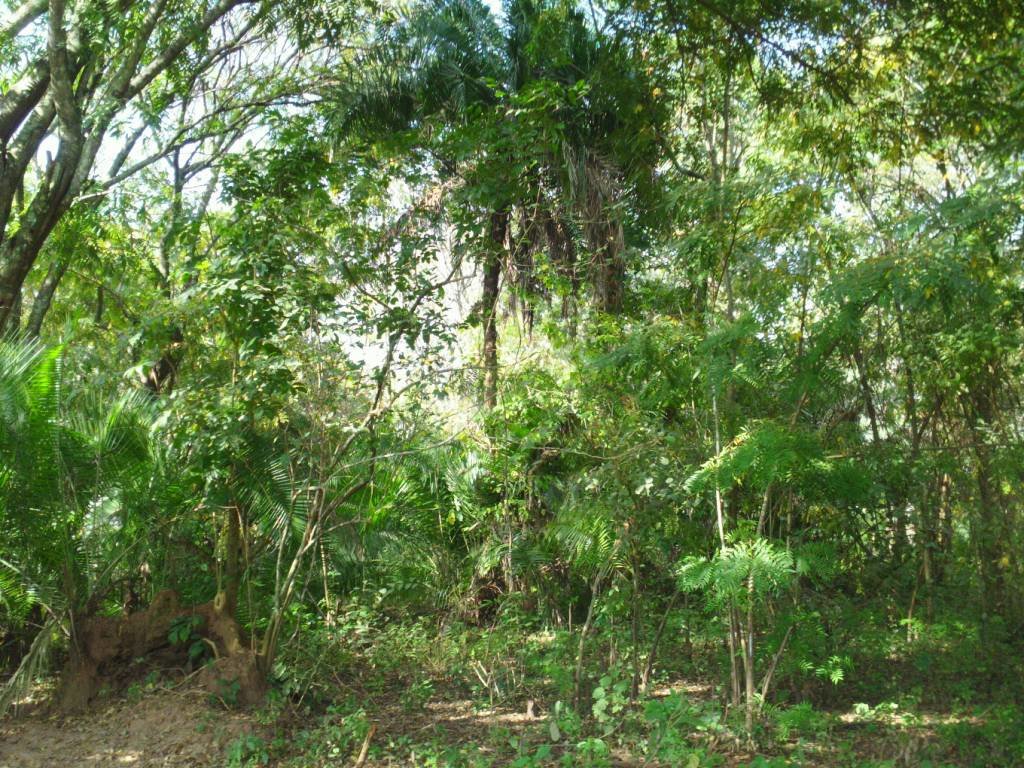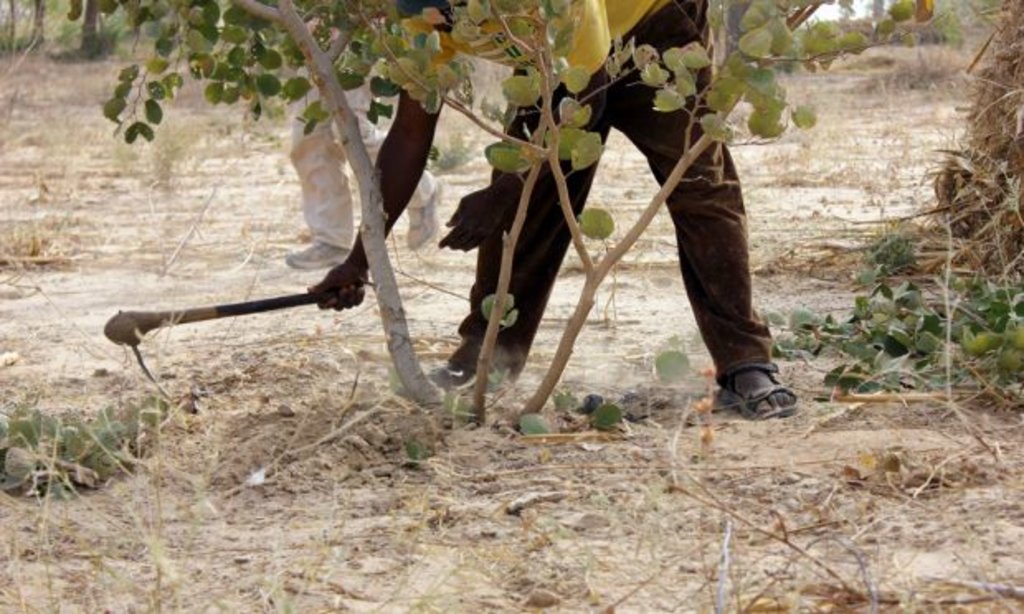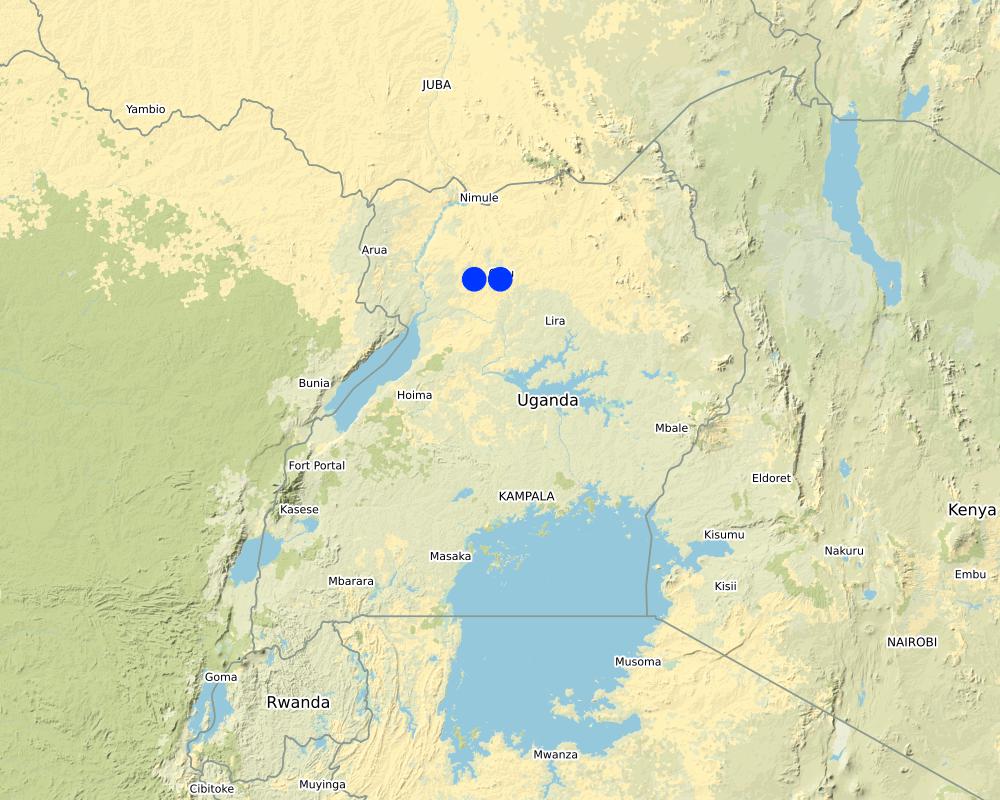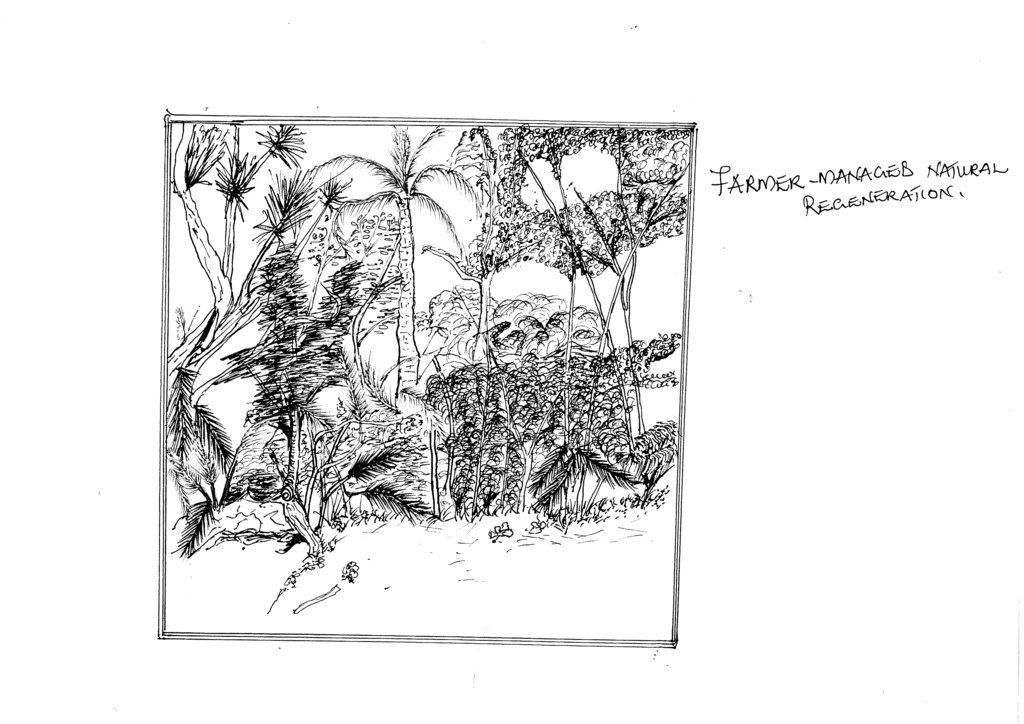Farmer-Managed Natural Regeneration (FMNR) [乌干达]
- 创建:
- 更新:
- 编制者: Bernard Fungo
- 编辑者: Kamugisha Rick Nelson, JOY TUKAHIRWA, betty adoch, Sunday Balla Amale
- 审查者: Drake Mubiru, Nicole Harari, Udo Höggel
Bunga
technologies_2769 - 乌干达
查看章节
全部展开 全部收起1. 一般信息
1.2 参与该技术评估和文件编制的资源人员和机构的联系方式
关键资源人
土地使用者:
Otto John Bosco
+256774140808
Farmer
Omolo District
乌干达
有助于对技术进行记录/评估的项目名称(如相关)
Scaling-up SLM practices by smallholder farmers (IFAD)有助于对技术进行记录/评估的机构名称(如相关)
CDE Centre for Development and Environment (CDE Centre for Development and Environment) - 瑞士1.3 关于使用通过WOCAT记录的数据的条件
(现场)数据是什么时候汇编的?:
25/05/2017
编制者和关键资源人员接受有关使用通过WOCAT记录数据的条件。:
是
1.4 所述技术的可持续性声明
这里所描述的技术在土地退化方面是否存在问题,导致无法被认为是一种可持续的土地管理技术?:
否
2. SLM技术的说明
2.1 技术简介
技术定义:
Farmer-managed natural regeneration is a low-cost, sustainable land restoration technique involving the re-growth of trees from tree stumps and seedlings in the wild.
2.2 技术的详细说明
说明:
Farmer-Managed Natural Regeneration (FMNR) involves encouraging existing tree stumps or self-sown seeds to re-grow into trees by pruning and protecting them. FMNR adapts centuries-old methods of woodland management, called coppicing and pollarding, to produce continuous tree-growth of trees from stumps or seedlings. It can be used wherever there is living tree stumps with the ability to coppice (re-sprout) or seeds in the soil that can germinate. FMNR is both a community mobilization approach for landscape restoration, and a specific technique to regenerate trees.
FMNR depends on the existence of living tree stumps or roots in crop fields, grazing pastures, woodlands or forests. Each season bushy sprouts will emerge from the stumps/ roots, often appearing like small shrubs. Continuous grazing by livestock, regular burning and/ or regular harvesting for wood fuel results in these sprouts never attaining tree stature. On farmland, standard practice has been for farmers to slash these sprouts in preparation for planting crops, but with a little attention the sprouts can be turned into mature trees without jeopardizing, but in fact, enhancing crop yields (Ndour, et a., 2010; Garity et al., 2010).
For each stump, a decision is made as to how many stems will be chosen to grow. On average, 2-3, are recommended. The tallest and most straight stems are selected and the remaining stems culled. Best results are obtained when the farmer returns regularly to prune any unwanted new stems and side branches as they appear. Farmers can then grow other crops between and around the trees, such as maize, sorghum, sesame, beans and cowpeas. Whenever farmers want wood for any purpose, e.g. building poles, wood fuel, stakes, trellis, etc., they can cut the stem(s) they want and leave the rest to continue growing. The remaining stems will increase in size and value each year, and will continue to protect the environment. Each time a stem is harvested, a younger stem is selected to replace it (Rinauldo, 2012).
FMNR is applicable in dry lands where it is capable of returning degraded croplands and grazing lands to productivity. It is also used to restore degraded forests, thereby reversing biodiversity loss and reducing vulnerability to climate change. Furthermore, the practice has a big role in maintaining not-yet-degraded landscapes in a productive state when combined with other sustainable land management practices such as conservation agriculture on cropland and holistic management on rangelands.
The farmer likes FMNR because of the direct benefits such as wood fuel, building materials, food and fodder without the need for frequent and costly replanting. Also, when FMNR trees are integrated into croplands and grazing pastures there is an increase in soil fertility and organic matter, soil moisture, leaf fodder, and crop yields. There is also a decrease in wind and heat damage, and soil erosion. FMNR is a rapid, relatively low-cost and easily replicable technology for restoring and improving agricultural, forested and pasture lands.
Farmers dislike FMNR because the tree species, which are mainly native, grow slowly compared to other comparable species such as Eucalyptus and Pine. Native trees also grow in random locations in the landscape depending on the location of the previous trees/seeds, making it difficult to plan arrangement of other farm activities.
2.3 技术照片
2.4 技术视频
2.5 已应用该技术的、本评估所涵盖的国家/地区/地点
国家:
乌干达
区域/州/省:
Gulu and Nwoya districts
Map
×2.6 实施日期
注明实施年份:
2014
2.7 技术介绍
详细说明该技术是如何引入的:
- 通过项目/外部干预
注释(项目类型等):
Trained by the organisation 'Operation Wealth Creation'
3. SLM技术的分类
3.1 该技术的主要目的
- 改良生产
- 减少、预防、恢复土地退化
- 保护生态系统
- 结合其他技术保护流域/下游区域
- 适应气候变化/极端天气及其影响
- 创造有益的经济影响
3.2 应用该技术的当前土地利用类型

森林/林地
(半天然)天然森林/林地:
- 选伐
植树造林:
- 混交品种
产品和服务:
- 木材
- 薪材
- 水果和坚果
- 其它森林产品
- 放牧/啃牧
- 自然保持/保护

混合(作物/放牧/树木),包括农林
- 农林业
如果由于技术的实施而导致土地用途发生变化,则在技术实施前说明土地利的用途。:
The land was initially un-managed woodland but now used for controlled grazing and bee-keeping
3.3 有关土地利用的更多信息
该技术所应用土地的供水:
- 雨养
每年的生长季节数:
- 2
牲畜密度(如相关):
Appoximately 10 animal units per acre
3.4 该技术所属的SLM组
- 天然和半天然森林管理
- 农业林学
- 畜牧业和牧场管理
3.5 技术传播
具体说明该技术的分布:
- 均匀地分布在一个区域
如果该技术均匀地分布在一个区域上,请注明覆盖的大致区域。:
- < 0.1 平方千米(10 公顷)
3.6 包含该技术的可持续土地管理措施

植物措施
- V4:更换或清除外来/入侵物种

管理措施
- M1:改变土地使用类型
- M2:改变管理/强度级别
- M4:活动时间安排的重大变化
- M5:物种组成的控制/变化
3.7 该技术强调的主要土地退化类型

土壤水蚀
- Wo:场外劣化效应

生物性退化
- Bs:质量和物种组成/多样性的下降
3.8 防止、减少或恢复土地退化
具体数量名该技术与土地退化有关的目标:
- 减少土地退化
- 修复/恢复严重退化的土地
4. 技术规范、实施活动、投入和成本
4.1 该技术的技术图纸
4.2 技术规范/技术图纸说明
1. Spacing between trees is is 10 to 30 meters
2. Each tree stump should be pruned, leaving 3 - 4 offshots to allow for proper continued growth
3. Other farming activities such as controlled grazing and bee-keeping may be included
4.3 有关投入和成本计算的一般信息
具体说明成本和投入是如何计算的:
- 每个技术区域
注明尺寸和面积单位:
1 acre
其它/国家货币(具体说明):
UGX
注明美元与当地货币的汇率(如相关):1美元=:
3500.0
注明雇用劳工的每日平均工资成本:
5000
4.4 技术建立活动
| 活动 | 措施类型 | 时间 | |
|---|---|---|---|
| 1. | Pruning of tree stumps and seedlings | 农业学的 | Once at the time of establishment |
| 2. | Fencing | 结构性的 | Once at the start of the establishment |
4.5 技术建立所需要的费用和投入
| 对投入进行具体说明 | 单位 | 数量 | 单位成本 | 每项投入的总成本 | 土地使用者承担的成本% | |
|---|---|---|---|---|---|---|
| 劳动力 | Pruning of stumps and seedlings | Acres | 1.0 | 150000.0 | 150000.0 | 100.0 |
| 劳动力 | Fencing | Acres | 1.0 | 200000.0 | 200000.0 | 100.0 |
| 施工材料 | Poles for fencing | Number | 300.0 | 5000.0 | 1500000.0 | 100.0 |
| 施工材料 | Barbed wire | kgs | 50.0 | 20000.0 | 1000000.0 | 100.0 |
| 技术建立所需总成本 | 2850000.0 | |||||
注释:
Money used by the land user to establish the technology was borrowed from the SACCO
4.6 维护/经常性活动
| 活动 | 措施类型 | 时间/频率 | |
|---|---|---|---|
| 1. | Pruning | 农业学的 | Approximately once a year |
4.7 维护/经常性活动所需要的费用和投入(每年)
| 对投入进行具体说明 | 单位 | 数量 | 单位成本 | 每项投入的总成本 | 土地使用者承担的成本% | |
|---|---|---|---|---|---|---|
| 劳动力 | Labour for pruning | acre | 1.0 | 150000.0 | 150000.0 | 100.0 |
| 施工材料 | Replacement of poles | Number | 20.0 | 5000.0 | 100000.0 | 100.0 |
| 技术维护所需总成本 | 250000.0 | |||||
4.8 影响成本的最重要因素
描述影响成本的最决定性因素:
Labour and seedlings take most of the costs of the technology
5. 自然和人文环境
5.1 气候
年降雨量
- < 250毫米
- 251-500毫米
- 501-750毫米
- 751-1,000毫米
- 1,001-1,500毫米
- 1,501-2,000毫米
- 2,001-3,000毫米
- 3,001-4,000毫米
- > 4,000毫米
注明所考虑的参考气象站名称:
Gulu
农业气候带
- 半湿润
5.2 地形
平均坡度:
- 水平(0-2%)
- 缓降(3-5%)
- 平缓(6-10%)
- 滚坡(11-15%)
- 崎岖(16-30%)
- 陡峭(31-60%)
- 非常陡峭(>60%)
地形:
- 高原/平原
- 山脊
- 山坡
- 山地斜坡
- 麓坡
- 谷底
垂直分布带:
- 0-100 m a.s.l.
- 101-500 m a.s.l.
- 501-1,000 m a.s.l.
- 1,001-1,500 m a.s.l.
- 1,501-2,000 m a.s.l.
- 2,001-2,500 m a.s.l.
- 2,501-3,000 m a.s.l.
- 3,001-4,000 m a.s.l.
- > 4,000 m a.s.l.
说明该技术是否专门应用于:
- 不相关
5.3 土壤
平均土层深度:
- 非常浅(0-20厘米)
- 浅(21-50厘米)
- 中等深度(51-80厘米)
- 深(81-120厘米)
- 非常深(> 120厘米)
土壤质地(表土):
- 中粒(壤土、粉土)
土壤质地(地表以下> 20厘米):
- 中粒(壤土、粉土)
表土有机质:
- 低(<1%)
5.4 水资源可用性和质量
地下水位表:
5-50米
地表水的可用性:
中等
水质(未处理):
不良饮用水(需要处理)
水的盐度有问题吗?:
否
该区域正在发生洪水吗?:
否
5.5 生物多样性
物种多样性:
- 中等
栖息地多样性:
- 中等
5.6 应用该技术的土地使用者的特征
定栖或游牧:
- 定栖的
生产系统的市场定位:
- 混合(生计/商业
非农收入:
- 低于全部收入的10%
- 收入的10-50%
相对财富水平:
- 贫瘠
个人或集体:
- 个人/家庭
机械化水平:
- 手工作业
性别:
- 女人
- 男人
土地使用者的年龄:
- 青年人
- 中年人
说明土地使用者的其他有关特征:
But mostly men
5.7 应用该技术的土地使用者拥有或租用的平均土地面积
- < 0.5 公顷
- 0.5-1 公顷
- 1-2 公顷
- 2-5公顷
- 5-15公顷
- 15-50公顷
- 50-100公顷
- 100-500公顷
- 500-1,000公顷
- 1,000-10,000公顷
- > 10,000公顷
这被认为是小规模、中规模还是大规模的(参照当地实际情况)?:
- 中等规模的
注释:
The farmer owns 10 acres of land
5.8 土地所有权、土地使用权和水使用权
土地所有权:
- 个人,未命名
土地使用权:
- 个人
用水权:
- 个人
注释:
The farmer is planning to acquire a land title
5.9 进入服务和基础设施的通道
健康:
- 贫瘠
- 适度的
- 好
教育:
- 贫瘠
- 适度的
- 好
技术援助:
- 贫瘠
- 适度的
- 好
就业(例如非农):
- 贫瘠
- 适度的
- 好
市场:
- 贫瘠
- 适度的
- 好
能源:
- 贫瘠
- 适度的
- 好
道路和交通:
- 贫瘠
- 适度的
- 好
饮用水和卫生设施:
- 贫瘠
- 适度的
- 好
金融服务:
- 贫瘠
- 适度的
- 好
6. 影响和结论性说明
6.1 该技术的现场影响
社会经济效应
生产
木材生产
森林/林地质量
注释/具体说明:
Well fenced, protected and no encroachment
生产故障风险
产品多样性
能源生产
收入和成本
农业投入费用
注释/具体说明:
Only paying labour for fencing
农业收入
注释/具体说明:
From the sale of forest products
收入来源的多样性
注释/具体说明:
From the sale of fruits and tree products like firewood, timber and staking materials
社会文化影响
食品安全/自给自足
土地使用权/用水权
娱乐机会
SLM/土地退化知识
冲突缓解
注释/具体说明:
Fencing: no roaming animals
生态影响
土壤
土壤水分
土壤覆盖层
土壤流失
土壤堆积
注释/具体说明:
Due to litter
土壤有机物/地下C
生物多样性:植被、动物
植被覆盖
生物量/地上C
外来入侵物种
6.2 该技术的场外影响已经显现
有关影响评估的意见:
Increased carbon sequestration by tree biomass
6.3 技术对渐变气候以及与气候相关的极端情况/灾害的暴露和敏感性(土地使用者认为的极端情况/灾害)
渐变气候
渐变气候
| 季节 | 气候变化/极端天气的类型 | 该技术是如何应对的? | |
|---|---|---|---|
| 年温度 | 增加 | 适度 | |
| 季节性温度 | 湿季/雨季 | 增加 | 适度 |
6.4 成本效益分析
技术收益与技术建立成本相比如何(从土地使用者的角度看)?
短期回报:
消极
长期回报:
积极
技术收益与技术维护成本/经常性成本相比如何(从土地使用者的角度看)?
短期回报:
稍微积极
长期回报:
积极
注释:
High costs at establishment. Costs continue reducing as maintenance is being done. Cost of maintenance can be recovered from the sale of prunigs and fuelwood and poles.
6.5 技术采用
- 1-10%
在所有采用这项技术的人当中,有多少人是自发地采用该技术,即未获得任何物质奖励/付款?:
- 90-100%
6.6 适应
最近是否对该技术进行了修改以适应不断变化的条件?:
否
6.7 该技术的优点/长处/机会
| 土地使用者眼中的长处/优势/机会 |
|---|
| Easy to manage once established |
| Can easily be replicated by small-scale and large-scale land users else where who own similar sizes of land |
| Fencing reduces conflict with other land users and eliminates open access situations leading to a free-for-all situation of land use which is not desirable. |
| 编制者或其他关键资源人员认为的长处/优势/机会 |
|---|
| The technology is replicable and suitable for small scale land users because it does not require a lot of costs at the time of establishment and maintenance |
| The technology is not expensive. The land user starts with local trees and shrubs. |
6.8 技术的弱点/缺点/风险及其克服方法
| 土地使用者认为的弱点/缺点/风险 | 如何克服它们? |
|---|---|
| Easily threatened by bush fires | Establish firelines |
| Benefits are realized after a long period of time(5-10 years) | Look for other sources of income |
| 编制者或其他关键资源人员认为的弱点/缺点/风险 | 如何克服它们? |
|---|---|
| Requires some capital at the time of establishment which the land user may not have | Engage in village and saving associations |
| Likelihood of conflict in areas where land is communally owned | Hold discussion with community before fencing-off sites |
7. 参考和链接
7.1 信息的方法/来源
- 实地考察、实地调查
01
- 与土地使用者的访谈
01
7.3 链接到网络上可用的相关信息
标题/说明:
Ndour, B., Sarr, A. and Mbaye, A. 2010. Projects Baysatol/ SFLEI – Rapport d'Activities, Institut Sénégalais de Recherches Agricoles (ISRA), Centre National de Recherches Agronomiques, Replublique du Senegal Ministere de l'Agriculture / World Vision Senegal.
URL:
http://fmnrhub.com.au/wp-content/uploads/2015/04/Francis-Weston-Birch-2015-FMNR-Study.pdf
标题/说明:
Garrity, D., Akinnifesi, F., Ajayi, O., Weldesemayat, S., Mowo, J., Kalinganire, A., Larwanou, M. and Bayala, J., 2010. Evergreen Agriculture: a robust approach to sustainable food security in Africa. Food Security 2. 197–214.
URL:
https://link.springer.com/article/10.1007/s12571-010-0070-7?shared-article-renderer
链接和模块
全部展开 全部收起链接
无链接
模块
无模块


